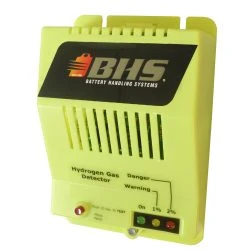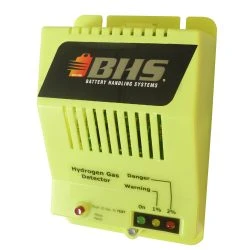BHS Hydrogen Gas Detectors (HGD)
Alpine Power Systems' experienced technical support & sales team is here to assist your needs:
BHS Hydrogen Gas Detectors (HGD) protect battery charging rooms and other locations where motive and stationary batteries are present by continuously monitoring hydrogen gas levels.

On this page:
BHS Hydrogen Gas Detectors (HGD) protect battery charging rooms and other locations where motive and stationary batteries are present by continuously monitoring hydrogen gas levels. The HGD is equipped with LED lights and an 80 dB alarm. AC- or DC-Powered models are available with single or dual relay.
Improving Safety in the Battery Room with BHS Hydrogen Gas Detectors
As a byproduct of the battery charging process, hydrogen gas accumulates in every battery room, and without robust ventilation systems, gas can accumulate to dangerous levels. Hydrogen mixes with oxygen to create a significant ignition hazard at a concentration of only four percent. Most safety measures recommend keeping hydrogen levels even lower, at less than one percent of the room’s total volume. The gas is colorless, odorless, and lighter than air, so it is very difficult to track without sensitive monitoring equipment.
The BHS Hydrogen Gas Detector (HGD) identifies hydrogen accumulation before it reaches a dangerous threshold. A hydrogen concentration of 1.00 percent activates the detector’s bright yellow LED light, while hydrogen levels of 2.00 percent or higher will trigger a flashing red LED light and an 80 decibel alarm.
The BHS HGD is designed for easy integration into your operation’s ventilation system. It is available with a single or dual relay, in AC- or DC-powered models. Relays automatically activate the venting action of the BHS Hydrogen Exhaust Fan Kit or other peripheral technologies, translating alarms directly into a coordinated preventative response.
Hydrogen Gas Safety Regulations and the BHS HGD
Many industrial and federal regulations require the presence of hydrogen gas monitoring systems like the BHS Hydrogen Gas Detector. As part of a complete battery ventilation system, the BHS HGD help maintain compliance with the following common safety standards:
29 CFR 1910.178(g)(2) – This OSHA regulation requires “adequate ventilation for dispersal of fumes from gassing batteries.”
IMC Chapter 5 Section 502.3 – Created by the International Fire Code Development Committee as part of the International Mechanical Code, this standard calls for ventilation in battery charging areas, along with “equipment to prevent a dangerous accumulation of flammable gasses.” The BHS HGD is a crucial component of such equipment.
NFPA 1: Fire Code Chapter 52.3.6: Ventilation – This standard from the National Fire Protection Association requires ventilation systems in stationary battery rooms to keep hydrogen at a maximum concentration of one percent; the BHS HGD reliably tracks this threshold.
IEEE Standard 484-2002 – The Institute of Electrical and Electronics Engineers also recommends robust detection and venting equipment for battery rooms, and the BHS HGD is an important part of any hydrogen response system.
Manufacturer


Find BHS Hydrogen Gas Detectors (HGD) in the following product categories:
Manufacturer





